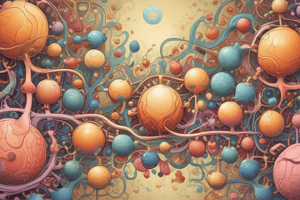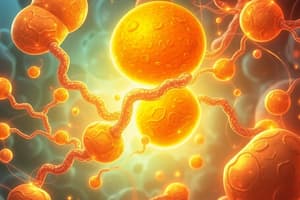Podcast
Questions and Answers
What is the primary action of phospholipase A2?
What is the primary action of phospholipase A2?
- Hydrolysis of phospholipids (correct)
- Formation of micelles
- Hydrolysis of carbohydrates
- Production of toxins
Which organism's venom contains phospholipase D that causes tissue damage?
Which organism's venom contains phospholipase D that causes tissue damage?
- Spiders (correct)
- Frogs
- Snakes
- Scorpions
What effect do the lipid products of hydrolysis by phospholipases in snake venoms have on victims?
What effect do the lipid products of hydrolysis by phospholipases in snake venoms have on victims?
- Enhance blood clot formation
- Neutralize small peptides
- Increase venom toxicity
- Lysis of red blood cells (correct)
In snake venoms with low concentrations of toxins, what is typically high?
In snake venoms with low concentrations of toxins, what is typically high?
What is a potential consequence of a bite from a snake with high phospholipase levels?
What is a potential consequence of a bite from a snake with high phospholipase levels?
What is the role of ATP in the formation of acyl-CoA?
What is the role of ATP in the formation of acyl-CoA?
In the first step of the reaction, what is formed alongside the acyl adenylate intermediate?
In the first step of the reaction, what is formed alongside the acyl adenylate intermediate?
What is produced in the overall reaction aside from acyl-CoA?
What is produced in the overall reaction aside from acyl-CoA?
Which component is crucial for the thioester formation in the reaction?
Which component is crucial for the thioester formation in the reaction?
What type of reaction is involved in the conversion of acyl adenylate to acyl-CoA?
What type of reaction is involved in the conversion of acyl adenylate to acyl-CoA?
How many moles of ATP are generated from the complete oxidation of one mole of stearic acid?
How many moles of ATP are generated from the complete oxidation of one mole of stearic acid?
What is the equivalent of ATP that must be subtracted during the activation step of stearic acid?
What is the equivalent of ATP that must be subtracted during the activation step of stearic acid?
How many FADH2 molecules are produced from the β-oxidation of stearic acid?
How many FADH2 molecules are produced from the β-oxidation of stearic acid?
What happens to the molecules of NADH and FADH2 in the oxidation of stearic acid?
What happens to the molecules of NADH and FADH2 in the oxidation of stearic acid?
How many moles of acetyl-CoA are produced from the β-oxidation of one mole of stearic acid?
How many moles of acetyl-CoA are produced from the β-oxidation of one mole of stearic acid?
In the citric acid cycle, how many GTP molecules are formed from the oxidation of 9 acetyl-CoA?
In the citric acid cycle, how many GTP molecules are formed from the oxidation of 9 acetyl-CoA?
What is the total number of NADH molecules generated from the citric acid cycle for the complete oxidation of stearic acid?
What is the total number of NADH molecules generated from the citric acid cycle for the complete oxidation of stearic acid?
Which reaction step contributes the least to the total ATP yield from stearic acid oxidation?
Which reaction step contributes the least to the total ATP yield from stearic acid oxidation?
Where does the esterification of fatty acids primarily take place?
Where does the esterification of fatty acids primarily take place?
What is the primary site of action for phospholipase A2?
What is the primary site of action for phospholipase A2?
What activates triacylglycerol lipase in adipose tissue?
What activates triacylglycerol lipase in adipose tissue?
Which fatty acids can serve as substrates for phosphoacylglycerol enzymes?
Which fatty acids can serve as substrates for phosphoacylglycerol enzymes?
What must happen for the oxidation process of fatty acids to proceed?
What must happen for the oxidation process of fatty acids to proceed?
Which enzyme is NOT named after its historical accident?
Which enzyme is NOT named after its historical accident?
Which component is NOT involved in the liberation of fatty acids from triacylglycerols?
Which component is NOT involved in the liberation of fatty acids from triacylglycerols?
Which type of fatty acids do phospholipases specifically target?
Which type of fatty acids do phospholipases specifically target?
What is released as a result of the action of triacylglycerol lipase?
What is released as a result of the action of triacylglycerol lipase?
Which of the following enzymes has a historical naming origin?
Which of the following enzymes has a historical naming origin?
How many moles of ATP can be obtained from the complete oxidation of one mole of glucose?
How many moles of ATP can be obtained from the complete oxidation of one mole of glucose?
Why do fatty acids yield more ATP than carbohydrates for the same number of carbon atoms?
Why do fatty acids yield more ATP than carbohydrates for the same number of carbon atoms?
What is a significant characteristic of the metabolic water produced during the oxidation of nutrients?
What is a significant characteristic of the metabolic water produced during the oxidation of nutrients?
What adaptation allows kangaroo rats to thrive in desert environments?
What adaptation allows kangaroo rats to thrive in desert environments?
In comparison to glucose, how many ATP molecules are produced from three glucose molecules?
In comparison to glucose, how many ATP molecules are produced from three glucose molecules?
What role does metabolic water play for camels during desert trips?
What role does metabolic water play for camels during desert trips?
What product is formed during the aerobic oxidation of both fatty acids and carbohydrates?
What product is formed during the aerobic oxidation of both fatty acids and carbohydrates?
Which of the following statements is true regarding the oxidation of fatty acids?
Which of the following statements is true regarding the oxidation of fatty acids?
What is produced when citrate is exported to the cytosol?
What is produced when citrate is exported to the cytosol?
What role does NADPH play in fatty acid biosynthesis?
What role does NADPH play in fatty acid biosynthesis?
What is the first product formed during the carboxylation of acetyl-CoA?
What is the first product formed during the carboxylation of acetyl-CoA?
Which enzyme complex catalyzes the production of malonyl-CoA from acetyl-CoA?
Which enzyme complex catalyzes the production of malonyl-CoA from acetyl-CoA?
What key components are required for the activity of acetyl-CoA carboxylase?
What key components are required for the activity of acetyl-CoA carboxylase?
Which of the following statements about biotin in the enzyme complex is true?
Which of the following statements about biotin in the enzyme complex is true?
What does the carboxylation of acetyl-CoA directly produce?
What does the carboxylation of acetyl-CoA directly produce?
Which of the following enzymes does NOT form part of the acetyl-CoA carboxylase complex?
Which of the following enzymes does NOT form part of the acetyl-CoA carboxylase complex?
Flashcards
Stearic Acid Oxidation
Stearic Acid Oxidation
The complete breakdown of a stearic acid molecule to produce ATP.
Activation Step (Stearic acid)
Activation Step (Stearic acid)
Conversion of stearic acid to stearyl-CoA, requiring 2 ATP molecules.
Beta-oxidation
Beta-oxidation
A metabolic process that breaks down fatty acid chains into acetyl-CoA molecules.
Acetyl-CoA
Acetyl-CoA
Signup and view all the flashcards
Citric Acid Cycle
Citric Acid Cycle
Signup and view all the flashcards
NADH and FADH2
NADH and FADH2
Signup and view all the flashcards
ATP Production (Stearic Acid)
ATP Production (Stearic Acid)
Signup and view all the flashcards
Theoretical ATP Yield
Theoretical ATP Yield
Signup and view all the flashcards
Phospholipase A2
Phospholipase A2
Signup and view all the flashcards
Phospholipase D
Phospholipase D
Signup and view all the flashcards
Snake Venom Phospholipases
Snake Venom Phospholipases
Signup and view all the flashcards
Lipid Hydrolysis Effects
Lipid Hydrolysis Effects
Signup and view all the flashcards
Snakebite Outcome
Snakebite Outcome
Signup and view all the flashcards
Fatty Acid Oxidation
Fatty Acid Oxidation
Signup and view all the flashcards
Phospholipases
Phospholipases
Signup and view all the flashcards
Fatty Acid Activation
Fatty Acid Activation
Signup and view all the flashcards
Mitochondrial Matrix
Mitochondrial Matrix
Signup and view all the flashcards
Hormone-Dependent Activation
Hormone-Dependent Activation
Signup and view all the flashcards
Triacylglycerol
Triacylglycerol
Signup and view all the flashcards
Adenylate Cyclase
Adenylate Cyclase
Signup and view all the flashcards
Protein Kinase
Protein Kinase
Signup and view all the flashcards
Cytosol
Cytosol
Signup and view all the flashcards
Fatty acid transport
Fatty acid transport
Signup and view all the flashcards
Acyl-CoA Synthesis
Acyl-CoA Synthesis
Signup and view all the flashcards
Acyl-Adenylate
Acyl-Adenylate
Signup and view all the flashcards
CoA-SH
CoA-SH
Signup and view all the flashcards
Acyl-CoA Synthetase
Acyl-CoA Synthetase
Signup and view all the flashcards
Fatty Acid Activation
Fatty Acid Activation
Signup and view all the flashcards
Fatty Acid Oxidation
Fatty Acid Oxidation
Signup and view all the flashcards
ATP Yield (Fatty Acids)
ATP Yield (Fatty Acids)
Signup and view all the flashcards
Reduced State of Fatty Acids
Reduced State of Fatty Acids
Signup and view all the flashcards
Metabolic Water Production
Metabolic Water Production
Signup and view all the flashcards
Camel Adaptation
Camel Adaptation
Signup and view all the flashcards
Kangaroo Rat Example
Kangaroo Rat Example
Signup and view all the flashcards
Aerobic Metabolism
Aerobic Metabolism
Signup and view all the flashcards
Reduced Electron Carriers
Reduced Electron Carriers
Signup and view all the flashcards
Acetyl-CoA Carboxylase
Acetyl-CoA Carboxylase
Signup and view all the flashcards
Malonyl-CoA
Malonyl-CoA
Signup and view all the flashcards
Fatty Acid Biosynthesis
Fatty Acid Biosynthesis
Signup and view all the flashcards
Citrate Export
Citrate Export
Signup and view all the flashcards
Oxaloacetate
Oxaloacetate
Signup and view all the flashcards
NADPH
NADPH
Signup and view all the flashcards
Biotin
Biotin
Signup and view all the flashcards
Acetyl-CoA Carboxylase Complex
Acetyl-CoA Carboxylase Complex
Signup and view all the flashcards
Study Notes
Lipid Metabolism
- Lipids are involved in energy generation and storage.
- Carbohydrate polymers (starch, glycogen) store energy, which can be broken down for energy.
- Lipid oxidation (fatty acid oxidation) releases large amounts of energy, producing acetyl-CoA, NADH, and FADH2.
- Triacylglycerols and phosphoacylglycerols are important lipid storage forms.
- Lipases and phospholipases hydrolyze lipids.
- Fatty acid activation involves a thioester bond between a fatty acid and CoA. This requires ATP.
- Activated fatty acids (acyl-CoA) enter the mitochondrial matrix for oxidation.
- Acyl-CoA can’t cross the inner mitochondrial membrane, so carnitine shuttles acyl groups across the inner membrane.
- Fatty acid oxidation (β-oxidation) is a cyclic process that cleaves 2-carbon units from fatty acids, producing acetyl-CoA. Each cycle yields FADH₂ and NADH.
- Even-numbered fatty acids yield acetyl-CoA, whereas odd-numbered fatty acids yield propionyl-CoA (which needs a separate pathway to enter the citric acid cycle).
- Monounsaturated fatty acids require isomerization for complete β-oxidation.
- Polyunsaturated fatty acids require additional enzymes to handle multiple double bonds.
Ketone Bodies
- Ketone bodies are produced when excess acetyl-CoA from β-oxidation cannot enter the citric acid cycle.
- This happens in conditions like starvation or uncontrolled diabetes.
- Ketone bodies include acetoacetate, β-hydroxybutyrate, and acetone.
- Ketone bodies are an alternative energy source for tissues like the brain and heart.
- Excessive ketone bodies can cause ketosis and ketoacidosis (low blood pH).
Fatty Acid Biosynthesis
- Fatty acid biosynthesis occurs in the cytosol, not in the mitochondrial matrix.
- Acetyl-CoA is transported from the mitochondria to the cytosol as citrate.
- Acetyl-CoA carboxylation, producing malonyl-CoA, is a key step in fatty acid synthesis. This step is catalyzed by acetyl-CoA carboxylase.
- Fatty acid synthase is a complex enzyme carrying out the successive addition of two carbon units to the fatty acid chain.
- Acetyl-CoA to acyl carrier protein and then malonyl-CoA to ACP.
- Repeated cycles of condensation, reduction, dehydration, and reduction reactions produce progressively longer fatty acid chains.
- The process terminates when a sixteen-carbon saturated fatty acid (palmitate) is synthesized.
Cholesterol Biosynthesis
- Cholesterol is synthesized from acetyl-CoA.
- Three acetyl units condense to form mevalonate.
- Mevalonate is converted to isoprene units, and then to squalene.
- Squalene is converted to lanosterol, and then to cholesterol.
- HMG-CoA reductase is a key enzyme in cholesterol biosynthesis; it's often a drug target.
- Cholesterol is a precursor for other steroids (bile acids, steroid hormones).
- Cholesterol is transported in the blood by lipoproteins (LDL, HDL).
- High levels of LDL cholesterol contribute to atherosclerosis (plaque formation in arteries).
Studying That Suits You
Use AI to generate personalized quizzes and flashcards to suit your learning preferences.




